Audio Performance
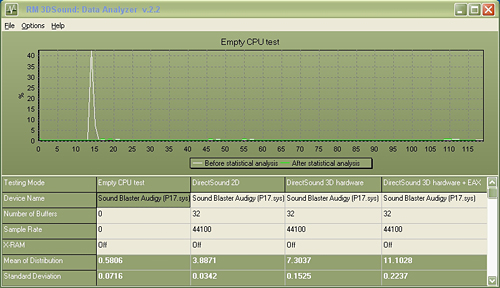
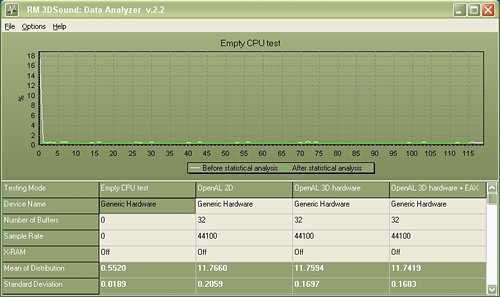
We limited audio testing to the Rightmark 3D Sound version 2.2 CPU utilization test and tested with sound enabled to show the performance effects on several games. The Rightmark 3D Sound benchmark measures the overhead or CPU utilization required by a codec or hardware audio chip.
The Realtek HD audio codec family was tested with the recently released 1.34 driver set and the Realtek AC97 codecs with the 3.84 driver set. We tested the Sound Blaster Audigy SE with the 5.12.1.519 driver set. The Realtek HD DirectSound audio drivers do not support more than 32 hardware buffers and the OpenAL 1.1 drivers do not support more than 30 hardware buffers at this time so the scores cannot be directly compared to the Creative Labs Sound Blaster X-FI and Sound Blaster Audigy SE in the benchmarks.
Although Creative Labs is marketing the CA0106-DAT codec as a Sound Blaster Audigy SE, it is actually the same chipset used in the Sound Blaster Live! 24-bit family of products. The CA0106-DAT is paired with the excellent Wolfson WM8775 ADC and Cirus Logic CS4382 DAC to provide 8-channel audio capability, 100dB SNR rating, and 24-bit/96KHz operation. This combination fully supports EAX 1/2/3 and OpenAL 1.1 but did not provide EAX3 (HD) positional audio via hardware in our testing.
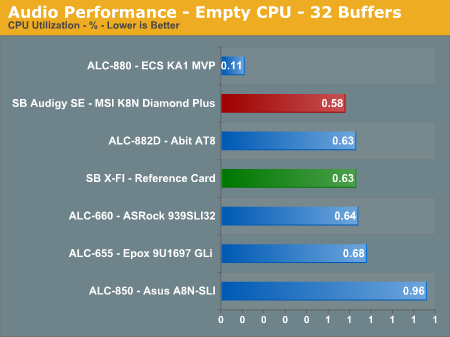
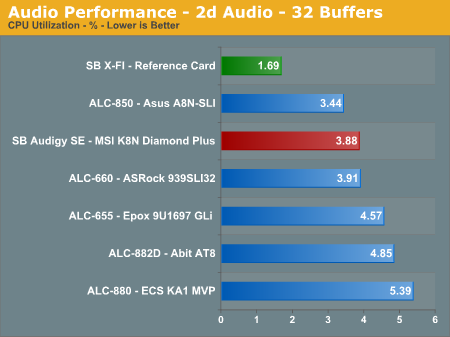

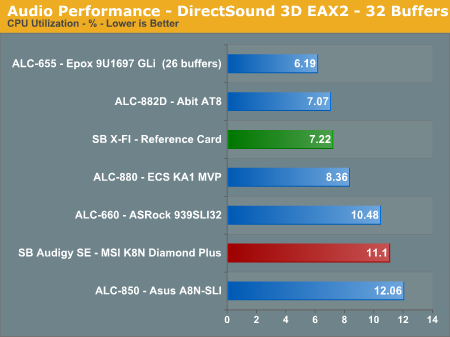
The Sound Blaster Audigy SE codec offers competitive CPU utilization rates when compared to the Realtek series of codecs. The SB Audigy SE generates better gaming audio quality than the Realtek ALC-882 based systems and similar DVD/music audio quality. In our subjective headphone testing we noticed differences between the two codecs, with the output from the ALC-882 sounding cleaner in the mid-range tones with deeper bass in the music and DVD movie playback tests while ambient sounds and positioning in the games tests clearly favored the SB Audigy SE. However, the difference was minor when utilizing our 4, 5.1, or 7.1 speaker setup in a typical room environment. The Sound Blaster X-FI has the lowest overall rates with the Realtek solutions and SB Audigy SE following closely. Let's find out how these results translate into real world numbers.
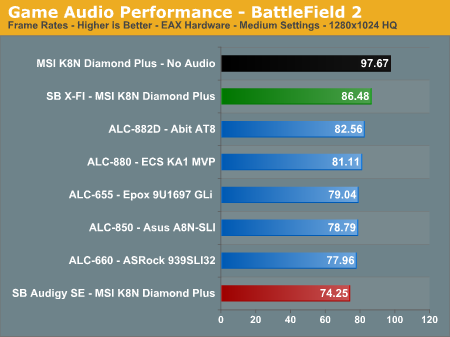
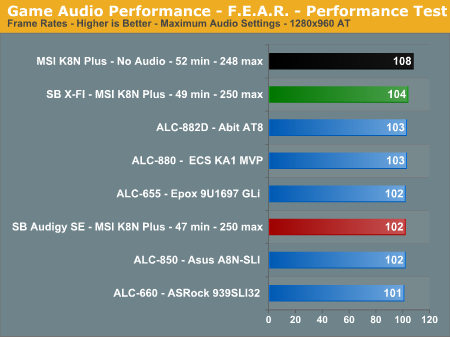
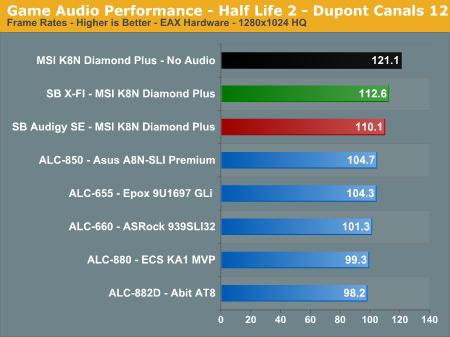
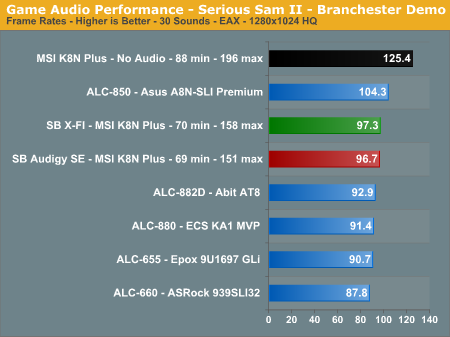
The audio performance numbers remain consistent as the Sound Blaster Audigy SE finishes behind the SoundBlaster X-FI while trading places with the Realtek audio solutions. Serious Sam II has an average loss of 30%, Battlefield 2 at 31%, Half Life 2 at 10%, and F.E.A.R. at 6%.
The output quality of audio with the Sound Blaster Audigy SE ranks closely with the Realtek ALC-882/883, while game performance is impressive for an on-board solution. The vast majority of users should have no issues utilizing the SB Audigy SE as their primary audio solution considering the audio quality and performance at this time.
Obviously, if you are a serious gamer, then a dedicated sound card is still useful to ensure consistent frame rate averages across a wide variety of games, and in the case of the Sound Blaster X-FI you also get improved audio quality and EAX4/5 support.


We limited audio testing to the Rightmark 3D Sound version 2.2 CPU utilization test and tested with sound enabled to show the performance effects on several games. The Rightmark 3D Sound benchmark measures the overhead or CPU utilization required by a codec or hardware audio chip.
The Realtek HD audio codec family was tested with the recently released 1.34 driver set and the Realtek AC97 codecs with the 3.84 driver set. We tested the Sound Blaster Audigy SE with the 5.12.1.519 driver set. The Realtek HD DirectSound audio drivers do not support more than 32 hardware buffers and the OpenAL 1.1 drivers do not support more than 30 hardware buffers at this time so the scores cannot be directly compared to the Creative Labs Sound Blaster X-FI and Sound Blaster Audigy SE in the benchmarks.
Although Creative Labs is marketing the CA0106-DAT codec as a Sound Blaster Audigy SE, it is actually the same chipset used in the Sound Blaster Live! 24-bit family of products. The CA0106-DAT is paired with the excellent Wolfson WM8775 ADC and Cirus Logic CS4382 DAC to provide 8-channel audio capability, 100dB SNR rating, and 24-bit/96KHz operation. This combination fully supports EAX 1/2/3 and OpenAL 1.1 but did not provide EAX3 (HD) positional audio via hardware in our testing.




The Sound Blaster Audigy SE codec offers competitive CPU utilization rates when compared to the Realtek series of codecs. The SB Audigy SE generates better gaming audio quality than the Realtek ALC-882 based systems and similar DVD/music audio quality. In our subjective headphone testing we noticed differences between the two codecs, with the output from the ALC-882 sounding cleaner in the mid-range tones with deeper bass in the music and DVD movie playback tests while ambient sounds and positioning in the games tests clearly favored the SB Audigy SE. However, the difference was minor when utilizing our 4, 5.1, or 7.1 speaker setup in a typical room environment. The Sound Blaster X-FI has the lowest overall rates with the Realtek solutions and SB Audigy SE following closely. Let's find out how these results translate into real world numbers.




The audio performance numbers remain consistent as the Sound Blaster Audigy SE finishes behind the SoundBlaster X-FI while trading places with the Realtek audio solutions. Serious Sam II has an average loss of 30%, Battlefield 2 at 31%, Half Life 2 at 10%, and F.E.A.R. at 6%.
The output quality of audio with the Sound Blaster Audigy SE ranks closely with the Realtek ALC-882/883, while game performance is impressive for an on-board solution. The vast majority of users should have no issues utilizing the SB Audigy SE as their primary audio solution considering the audio quality and performance at this time.
Obviously, if you are a serious gamer, then a dedicated sound card is still useful to ensure consistent frame rate averages across a wide variety of games, and in the case of the Sound Blaster X-FI you also get improved audio quality and EAX4/5 support.










42 Comments
View All Comments
LoneWolf15 - Tuesday, April 11, 2006 - link
There are TV tuner cards based on ATI's Theater 550 chip, Powercolor makes one, details can be found here:http://www.powercolor.com/product_series_Theater.h...">http://www.powercolor.com/product_series_Theater.h...
Gary Key - Tuesday, April 11, 2006 - link
We are currently reviewing the Powercolor T55E-P03 for an upcoming HTPC article. I think the results against the PCI cards will be interesting. ;-)LoneWolf15 - Wednesday, April 12, 2006 - link
From what I've heard, there's little or no difference in performance. However, the Powercolor would be the card I'd consider for future-proofness.My only disappointment is it doesn't use ATI's Remote Wonder line of remote controls; they include an iR remote of their own choosing instead of the ATI RF model, IIRC.
nullpointerus - Tuesday, April 11, 2006 - link
Interesting, how? Better, worse, wierd, or just unspecified in a frustratingly vague kind of way? ;-)Gary Key - Wednesday, April 12, 2006 - link
Actual throughput was different than the PCI based card, not trying to be vague but I think the article we are putting together will explain it best, new benchmarks, software versus hardware, TV Tuners- single, dual, SD, and HD, single core CPU , dual core CPU, AMD, Intel, NVIDIA, ATI, MCE2005, Linux, PCI, PCI-E, USB, you know just the basics. ;-)
nullpointerus - Wednesday, April 12, 2006 - link
Cool, thanks. I'm looking forward to reading it.ceefka - Tuesday, April 11, 2006 - link
I don't quite get this one. I can imagine it would say something like 1394b can be had on a s939 Gigabyte board for less than $ 100,00 e.g. GA-K8NF9 Ultra. It seems Gigabyte is the only one with 1394b for s939.
Fact is though that there are few F800 devices out there. If you do have one of these, your mobo options are limited.
JarredWalton - Tuesday, April 11, 2006 - link
It should have been "can't be very large" of course. I'm a bit befuddled on how that slipped in there, because I know I corrected that once before. Must have accidentally pasted over the original text at some point.... Ah, well - fixed now regardless.Myrandex - Tuesday, April 11, 2006 - link
I agree too, there is no reason for manufacturer's to not include this. Firewire B devices will not be mass produced without the users with Firewire B ports. I have a Giga-byte s939 SLI mobo with Firewire B on there and I do want to purchase an external enclosure that supports the standard (along with A and USB), but I also wish we would get some highly OCable boards from the likes of Asus or Abit etc. that provides this feature for the future. And also I believe the article is wrong about the price difference being very large, or else you wouldn't see Giga-byte squeezing these into ~$100 boards with other manufacturer's at the same price point including only A (or no firewire at all).Jason
Duplex - Friday, April 14, 2006 - link
1394B to the people!!! Couldn't agree more!--
I also must give credit to MSI for including a parallel and serial port.
There aren't that many people with a printerserver or USB-printer at home (I think).